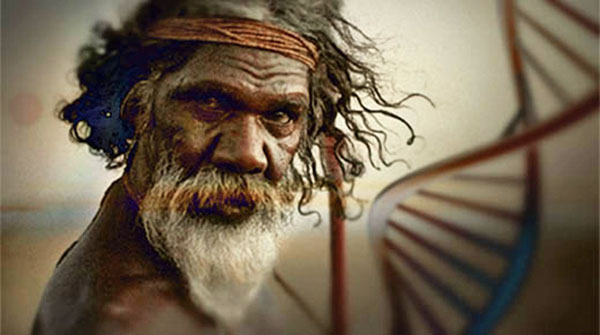|
from Ancient-Code Website
Ryan Bohlender and his colleagues have been researching the amount of extinct hominid DNA that modern humans still carry today.
To the surprise of many, they say they've found discrepancies in previous studies that suggest our mingling with Neanderthals and Denisovans isn't the entire evolutionary story.
Experts believe that this contact left a mark on our species that is still present today.
He explained that the new
study gathered the genetic data of 142 different human populations
scattered around the world that was underrepresented in large-scale
studies so far.
The incredible diversity in the genetic code of the native peoples of Australia, in addition to the peculiar genetic marker that indicates that they interbred with an unknown human species in the past, indicates that there is still much more to discover about the ancient history of humanity.
Unknown Extinct Human Relative People from Papua New Guinea (shown) and Australia carry small amounts of DNA from extinct human relatives. New research suggests that the DNA may not come from Neandertals or Denisovans, but from a third, previously unknown extinct hominid.
Melanesians carry genetic clues to hominid
not revealed by fossils
Traces of long-lost human cousins may be hiding in modern people's DNA, a new computer analysis suggests.
People from Melanesia, a region in the South Pacific encompassing Papua New Guinea and surrounding islands, may carry genetic evidence of a previously unknown extinct hominid species, Ryan Bohlender reported October 20 at the annual meeting of the American Society of Human Genetics.
That species is probably not Neandertal or Denisovan, but a different, related hominid group, said Bohlender, a statistical geneticist at the University of Texas MD Anderson Cancer Center in Houston.
This mysterious relative was probably from a third branch of the hominid family tree that produced Neandertals and Denisovans, an extinct distant cousin of Neandertals.
While many Neandertal fossils have been found in Europe and Asia, Denisovans are known only from DNA from a finger bone and a couple of teeth found in a Siberian cave (DNA hints at African Cousin to Humans).
Bohlender isn't the first to suggest that remnants of archaic human relatives may have been preserved in human DNA even though no fossil remains have been found.
In 2012, another group of researchers suggested that some people in Africa carry DNA heirlooms from an extinct hominid species (Neandertal DNA may raise Risk for some Modern Human Diseases).
Less than a decade ago, scientists discovered that human ancestors mixed with Neandertals. People outside of Africa still carry a small amount of Neandertal DNA, some of which may cause health problems.
Bohlender and colleagues calculate that Europeans and Chinese people carry a similar amount of Neandertal ancestry: about 2.8 percent. Europeans have no hint of Denisovan ancestry, and people in China have a tiny amount - 0.1 percent, according to Bohlender's calculations.
But 2.74 percent of the DNA in people in Papua New Guinea comes from Neandertals. And Bohlender estimates the amount of Denisovan DNA in Melanesians is about 1.11 percent, not the 3 to 6 percent estimated by other researchers.
While investigating the Denisovan discrepancy, Bohlender and colleagues came to the conclusion that a third group of hominids may have bred with the ancestors of Melanesians.
Another group of researchers, led by Eske Willerslev, an evolutionary geneticist at the Natural History Museum of Denmark in Copenhagen, recently came to a similar conclusion.
Willerslev's group examined DNA from 83 aboriginal Australians and 25 people from native populations in the Papua New Guinea highlands (Single exodus from Africa gave rise to today’s non-Africans).
The researchers found Denisovan-like DNA in the study (A Genomic History of Aboriginal Australia) volunteers, the group reported October 13 in Nature.
But the DNA is genetically distinct from Denisovans and may be from another extinct hominid.
They could be Homo erectus or the extinct hominids found in Indonesia known as Hobbits (Hobbits Died Out Earlier than Thought), he speculates.
But researchers don't know how genetically diverse Denisovans were, says Mattias Jakobsson, an evolutionary geneticist at Uppsala University in Sweden.
A different branch of Denisovans could be the group that mated with ancestors of Australians and Papuans.
Researchers know so little about the genetic makeup of extinct groups that it's hard to say whether the extinct hominid DNA actually came from an undiscovered species, said statistical geneticist Elizabeth Blue of the University of Washington in Seattle.
DNA has been examined from few Neandertal fossils, and Denisovan remains have been found only in that single cave in Siberia. Denisovans may have been widespread and genetically diverse.
If that were the case, said Blue, the Papuan's DNA could have come from a Denisovan population that had been separated from the Siberian Denisovans for long enough that they looked like distinct groups, much as Europeans and Asians today are genetically different from each other.
But if Denisovans were not genetically diverse, the mysterious extinct ancestor could well be another species, she said.
Jakobsson says he wouldn't be surprised if there were other groups of extinct hominids that mingled with humans.
|



